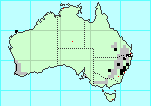
Common Name:
Delete this section if there is no common name.
Identification:
Length: 53mm.
Coloring: brownish-black.
Note any distinguishing features.
male and female apterous
The colour is of a dark sepia brown, with some white, and has much the
appearance of being scaly; the thorax and abdomen are keeled down their
centre. The latter is short with the base depressed, while the tip is
compressed; the legs are rather short, with elevated lines: but the
four posterior thighs have three teeth, placed at equal distances on
the upper sides.
(from
Gray, 1833)
 Note parental placement of eggs.
Note appearance of eggs.
Note any common variations.
Note parental placement of eggs.
Note appearance of eggs.
Note any common variations.
Habitat:
Note if the species arborial or terrestrial.
Canopy, mid, under, etc.
Note typical vegetation, e.g.
tropical rainforest, temperate rainforest,
grasslands,
alpine, etc.
Similar Species:
Rearing Notes:
Note if this species has ever been reared.
Note any suggestions for successful rearing.
For a stick insect with body length 53mm, to keep 2 adult females,
you need a cage at least 250mm high, 120mm deep and 120mm wide.
 Range:
Range:
lives amongst the foliage and branches of shrubs and
trees along the coast of central New South Wales.
known only from type locality
Status:
It is not known if this species is endangered,
as there is insufficient sighting history.
References
-
Balderson, J., Rentz,
D.C.F. and Roach, A.M.E. (1998).
in
Houston, W.K.K. & Wells, A. (1998) (eds)
Zoological Catalogue of Australia.
Vol. 23.
Archaeognatha, Zygentoma, Blattodea, Isoptera, Mantodea, Dermaptera,
Phasmatodea, Embioptera, Zoraptera.
Melbourne: CSIRO Publishing, Australia (ISBN 0643 06035 9).
pp. 347 - 376.
-
Bradley, J.C., and Galil, B.S. (1977).
The taxonomic arrangement of the Phasmatodea with keys to the subfamilies
and tribes.
Proceedings of the Entomological Society of Washington,
79(2): 176-208.
-
Clark, J.T. (1976).
The eggs of stick insects (Phasmida): a review with
descriptions of the eggs of eleven species.
Syst. Ent. 1: 95-105.
-
Gray, G.R. (1833).
The Entomology of Australia in a Series of Monographs. Part 1.
The monograph of the genus Phasma.
London: Longman & Co. 28 pp. 8 pls
-
Gray, G.R. (1835).
‘Synopsis of the Species of Insects Belonging to
the Family of Phasmidae.’ 48pp.
(Longman, Rees, Orme, Brown, Green and Longman: London.)
-
Heather, N.W. (1965).
Studies on female genitalia of Queensland Phasmida,
Journal of the Entomological Society of Queensland,
4: 33-38.
-
Key, K.H.L. (1970).
Phasmatodea (Stick-insects). pp. 394-404 in CSIRO (ed.) The
Insects of Australia. A textbook for students and research workers.
Melbourne: Melbourne University Press, Vol. 1, 1st Edn.
-
Kirby, W.F. (1904).
A Synonymic Catalogue of Orthoptera. 8vo. Vol. 1. Orthoptera,
Euplexoptera, Cursoria, et Gressoria (Forficulidæ, Hemimeridæ,
Blattidæ, Mantidæ, Phasmidæ). London: Longmans
& Co. x 501 pp.
-
Rainbow, W.J. (1897).
Catalogue of the described Phasmidae of Australia.
Records of the Australian Museum, 3(2), 37-44.
[Note that he made a mistake re Extatosoma popa and E. tiaratum
according to
Gurney, A.B. (1947).
Notes on some remarkable Australasian walkingsticks, including a
synopsis of the Genus Extatosoma (Orthoptera: Phasmatidae).
Annals of the Entomological Society of America. 40(3): 373-396.
.]
-
Rentz, D.C.F (1996).
Grasshopper Country,
Chapter 16,
Phasmatodea: Leaf and Stick Insects,
pp. 244-257
-
Tepper, J.G.O. (1902).
List of the Described Genera and Species of the Australian and Polynesian
Phasmidæ (Spectre-Insects).
Transactions of the Royal Society of South Australia, 26: 278-287.
-
Vickery, V.R. (1983).
Catalogue of Australian stick insects (Phasmida,
Phasmatodea, Phasmatoptera, or Cheleutoptera). CSIRO
Australian Division of Entomology Technical Paper, No. 20, 15 pp.
- Search Google for
Pachymorpha squalida,
or search Google Scholar for
Pachymorpha squalida.
Synonyms:
Copyright © 2000-2003
Peter Miller
This page was last changed 20-Sep-2006.
|

|

|
 Note parental placement of eggs.
Note appearance of eggs.
Note any common variations.
Note parental placement of eggs.
Note appearance of eggs.
Note any common variations.

 Note parental placement of eggs.
Note appearance of eggs.
Note any common variations.
Note parental placement of eggs.
Note appearance of eggs.
Note any common variations.
 Range:
Range: 
